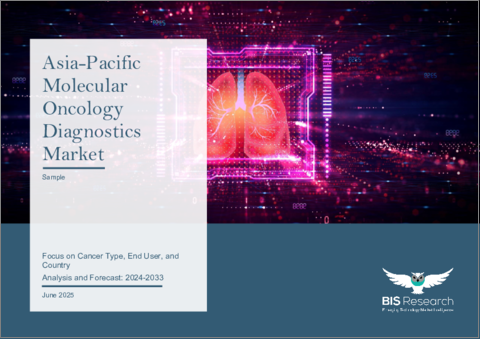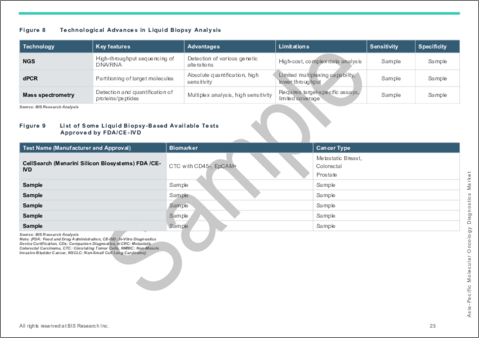|
|
市場調査レポート
商品コード
1752089
アジア太平洋の分子腫瘍診断市場:がんタイプ別、エンドユーザー別、国別 - 分析と予測(2024年~2033年)Asia-Pacific Molecular Oncology Diagnostics Market: Focus on Cancer Type, End User, and Country - Analysis and Forecast, 2024-2033 |
||||||
カスタマイズ可能
|
|||||||
| アジア太平洋の分子腫瘍診断市場:がんタイプ別、エンドユーザー別、国別 - 分析と予測(2024年~2033年) |
|
出版日: 2025年06月19日
発行: BIS Research
ページ情報: 英文 80 Pages
納期: 1~5営業日
|
- 全表示
- 概要
- 図表
- 目次
アジア太平洋の分子腫瘍学診断の市場規模は、2024年に5億1,360万米ドルとなりました。
同市場は、12.99%のCAGRで拡大し、2033年には15億4,200万米ドルに達すると予測されています。デジタルPCR、リキッドバイオプシー、次世代シーケンシング(NGS)は、アジア太平洋の分子がん診断市場の爆発的拡大を後押しする主な技術的要因です。より早期発見、より正確な治療法の選択、ひいては患者の転帰改善へのニーズは、中国、インド、日本などの国々におけるがん罹患率の上昇に後押しされています。
| 主要市場統計 | |
|---|---|
| 予測期間 | 2024年~2033年 |
| 2024年の評価 | 5億1,360万米ドル |
| 2033年予測 | 15億4,200万米ドル |
| CAGR | 12.99% |
しかし、多くの地域的な障害が、より広範な導入を妨げています。特に東南アジアなど、ヘルスケア資源が乏しい市場では、高度な分子診断薬の高額なコストが依然として大きな障壁となっています。さらに、この地域の多くの地域では、高度な診断システムを稼働させ、大量のゲノムデータを解読できる有資格の専門家が不足しています。
こうした障害にもかかわらず、アジア太平洋の市場は成長を続けています。イノベーションが加速し、バイオテクノロジー企業、製薬会社、診断薬メーカー、学術機関の協力により、分子ツールが日常的な腫瘍学ワークフローに組み込まれつつあります。利害関係者は、高精度がん診断の約束を完全に実現するためには、保険償還慣行の標準化、現地生産と規模拡大による検査コストの削減、様々な医療システム全体で臨床医のゲノムリテラシーを向上させるためのトレーニングイニシアティブに資金を提供する必要があります。
市場イントロダクション
アジア太平洋におけるがん分子診断薬市場は、中国、インド、日本、東南アジアのヘルスケアシステムが精密医療を重視するようになり、急成長が見込まれています。分子アッセイ、特に次世代シーケンシング(NGS)、デジタルPCR、リキッドバイオプシーの使用は、従来の技術よりもがんに関連する遺伝子の変化をより正確かつ早期に特定できることから増加しています。これらの最先端機器に対する需要は、大腸がん、肺がん、乳がんの有病率の上昇や、患者や医師の意識の高まりによって牽引されています。臨床への導入は、国家ゲノムプログラム、コンパニオン診断薬の推奨、検査施設インフラへの公的・民間投資によっても加速されています。検査価格の高騰、バラバラな規制手続き、特に低所得地域における適格なバイオインフォマティシャンや分子技術者の不足は、依然として大きな障害となっています。
業界関係者は、これらの障害を克服するために、戦略的提携を確立し、現地生産品を増やし、技術的ノウハウを開発するための研修イニシアティブを実施しています。一方、工程を迅速化し、納期を短縮するために、自動化された高スループット・プラットフォームが導入されつつあります。将来的には、AIを活用したバイオインフォマティクス、保険適用範囲の拡大、より強固なデータセキュリティの枠組みの組み合わせが、業界の長期的な拡大を促進するために不可欠となると思われます。さまざまなヘルスケア環境において、より個別化された効率的ながん治療を提供することで、アジア太平洋の分子腫瘍学診断市場は2030年までに世界のプレシジョン・オンコロジー市場のかなりの部分を占めると予想されます。
市場セグメンテーション
セグメンテーション1:がんタイプ別
- 固形がん
- 血液悪性腫瘍
セグメンテーション2:エンドユーザー別
- 病院および診断センター
- 参照試験所
- 製薬・バイオテクノロジー企業
- 学術・研究機関
セグメント3:地域別
- アジア太平洋地域- 日本、中国、インド、韓国、オーストラリア、その他
アジア太平洋の分子腫瘍診断市場動向と促進要因・課題:
市場動向
- 技術の進歩:次世代シーケンサー(NGS)、デジタルPCR、リキッドバイオプシー(ctDNA/ctC)別非侵襲的リアルタイムがんモニタリングの急速な普及
- 統合とパートナーシップ:M&Aの活発化により競合情勢が再構築され、ラボや診断薬の大手企業が先進的なプラットフォームの買収や提携を行います。
- コンパニオン診断薬の統合:患者を標的治療薬に適合させるためのCDxアッセイの採用が拡大し、日本やオーストラリアなどの主要市場における規制ガイドラインの進展が後押ししています。
- 自動化とハイスループットプラットフォーム:効率とサンプルスループットを向上させるため、臨床ラボと研究ラボの両方で自動化システムの導入が進みます。
市場促進要因
- がん罹患率の上昇:中国、インド、日本、東南アジアで乳がん、肺がん、大腸がんの発生率が急上昇しており、精密診断の需要に拍車をかけています。
- 精密医療の推進:個別化腫瘍学への戦略的転換が進み、支払者や医療提供者は遺伝子型に基づいた治療経路に投資しています。
- 政府と官民のイニシアチブ:ゲノミクス・ミッションやコンパニオン・ダイアグノスティックス・ガイドラインなど、インフラ拡充を引き受ける国家プログラムやパートナーシップ。
- ヘルスケアインフラ投資:ラボのアップグレード、バイオテクノロジー研究開発、がん専門センターへの資本流入により、地域の能力が強化されます。
市場の課題
- 検査コストの高さ:先進的な分子アッセイは依然として高価であるため、所得の低いアジア太平洋の市場での普及は限定的です。
- 規制の複雑さ:各国で承認経路が分断され、進化しているため、製品上市が遅れます。
- 熟練した人材の不足:訓練を受けた分子検査技師やバイオインフォマティシャンの数が不足しているため、より広範な臨床展開が妨げられています。
- データセキュリティとプライバシー:機密性の高いゲノムデータや患者データの取り扱いには、コンプライアンスやサイバーセキュリティ上の懸念があります。
目次
エグゼクティブサマリー
第1章 分子腫瘍診断市場:業界展望
- 世界のがんの発生率と有病率(がんタイプ別)
- アジア太平洋
- 動向:現状と将来への影響評価
- 参入企業間のパートナーシップの強化
- 分子腫瘍診断エコシステムにおける革新的な製品の発売と規制承認の増加
- 規制状況
- アジア太平洋の法的要件と枠組み
- COVID-19別分子腫瘍診断市場への影響
- 液体生検に基づくがん分子診断
- 臨床検査(LDT)と体外診断(IVD)
- 分子腫瘍学診断市場におけるコンパニオン診断の役割
- 市場力学
- 市場促進要因
- 市場の課題
- 市場機会
第2章 分子腫瘍診断市場:地域別
- 地域のサマリー
- 促進要因と抑制要因
- アジア太平洋
- 地域概要
- 市場成長促進要因
- 市場成長抑制要因
- がんタイプ別
- エンドユーザー別
- 中国
- インド
- 日本
- 韓国
- オーストラリア
- その他
- その他の地域
第3章 分子腫瘍診断市場-競合ベンチマーキングと企業プロファイル
- 企業プロファイル
- Sysmex Corporation
第4章 調査手法
List of Figures
- Figure 1 Asia-Pacific Molecular Oncology Diagnostics Market, $Million, 2024, 2028, and 2033
- Figure 2 Molecular Oncology Diagnostics Market (by Region), $Million, 2023, 2027, and 2033
- Figure 3 Asia-Pacific Molecular Oncology Diagnostics Market (by Cancer Type), $Million, 2023, 2027, and 2033
- Figure 4 Asia-Pacific Molecular Oncology Diagnostics Market (by End User), $Million, 2023, 2027, and 2033
- Figure 5 Role of Diagnostics in Healthcare
- Figure 6 Cancer Prevalence and Incidence (by Cancer Type), in Million, Asia-Pacific, 2022
- Figure 7 Workflow for Medical Device Regulations
- Figure 8 Technological Advances in Liquid Biopsy Analysis
- Figure 9 List of Some Liquid Biopsy-Based Available Tests Approved by FDA/CE-IVD
- Figure 10 Impact Analysis of Market Navigating Factors, 2022-2033
- Figure 11 Global Distribution of Cases and Deaths (by Cancer Type), 2022
- Figure 12 Global Incidence for Cancer Types, 2018-2022
- Figure 13 China Molecular Oncology Diagnostics Market, $Million, 2023-2033
- Figure 14 India Molecular Oncology Diagnostics Market, $Million, 2023-2033
- Figure 15 Japan Molecular Oncology Diagnostics Market, $Million, 2023-2033
- Figure 16 South Korea Molecular Oncology Diagnostics Market, $Million, 2023-2033
- Figure 17 Australia Molecular Oncology Diagnostics Market, $Million, 2023-2033
- Figure 18 Rest-of-Asia-Pacific Molecular Oncology Diagnostics Market, $Million, 2023-2033
- Figure 19 Data Triangulation
- Figure 20 Top-Down and Bottom-Up Approach
- Figure 21 Assumptions and Limitations
List of Tables
- Table 1: Market Snapshot
- Table 2: Key Trends, Impact Analysis
- Table 3: Molecular Oncology Diagnostics Market, Partnerships and Collaborations
- Table 4: Molecular Oncology Diagnostics Market, Product Launches and Regulatory Approvals
- Table 5: Prominent FDA-Approved Companion Diagnostics
- Table 6: Molecular Oncology Diagnostics Market, New Offerings
- Table 7: Biomarkers for Different Cancer Types
- Table 8: Significance of Different Biomarkers in Clinical Outcomes of Various Cancer
- Table 9: Cost of Liquid Biopsy-Based NGS Kits
- Table 10: Molecular Oncology Diagnostics Market, Reimbursement and Medical Coverage
- Table 11: Molecular Oncology Diagnostics Market (by Region), $Million, 2023-2033
- Table 12: Asia-Pacific Molecular Oncology Diagnostics Market (by Cancer Type), $Million, 2023-2033
- Table 13: Asia-Pacific Molecular Oncology Diagnostics Market, Cancer Type (by Solid Tumors), $Million, 2023-2033
- Table 14: Asia-Pacific Molecular Oncology Diagnostics Market, Cancer Type (by Hematological Malignancies), $Million, 2023-2033
- Table 15: Asia-Pacific Molecular Oncology Diagnostics Market (by End User), $Million, 2023-2033
- Table 16: China Molecular Oncology Diagnostics Market (by Cancer Type), $Million, 2023-2033
- Table 17: China Molecular Oncology Diagnostics Market, Cancer Type (by Solid Tumors), $Million, 2023-2033
- Table 18: China Molecular Oncology Diagnostics Market, Cancer Type (by Hematological Malignancies), $Million, 2023-2033
- Table 19: China Molecular Oncology Diagnostics Market (by End User), $Million, 2023-2033
- Table 20: India Molecular Oncology Diagnostics Market (by Cancer Type), $Million, 2023-2033
- Table 21: India Molecular Oncology Diagnostics Market, Cancer Type (by Solid Tumors), $Million, 2023-2033
- Table 22: India Molecular Oncology Diagnostics Market, Cancer Type (by Hematological Malignancies), $Million, 2023-2033
- Table 23: India Molecular Oncology Diagnostics Market (by End User), $Million, 2023-2033
- Table 24: Japan Molecular Oncology Diagnostics Market (by Cancer Type), $Million, 2023-2033
- Table 25: Japan Molecular Oncology Diagnostics Market, Cancer Type (by Solid Tumors), $Million, 2023-2033
- Table 26: Japan Molecular Oncology Diagnostics Market, Cancer Type (by Hematological Malignancies), $Million, 2023-2033
- Table 27: Japan Molecular Oncology Diagnostics Market (by End User), $Million, 2023-2033
- Table 28: South Korea Molecular Oncology Diagnostics Market (by Cancer Type), $Million, 2023-2033
- Table 29: South Korea Molecular Oncology Diagnostics Market, Cancer Type (by Solid Tumors), $Million, 2023-2033
- Table 30: South Korea Molecular Oncology Diagnostics Market, Cancer Type (by Hematological Malignancies), $Million, 2023-2033
- Table 31: South Korea Molecular Oncology Diagnostics Market (by End User), $Million, 2023-2033
- Table 32: Australia Molecular Oncology Diagnostics Market (by Cancer Type), $Million, 2023-2033
- Table 33: Australia Molecular Oncology Diagnostics Market, Cancer Type (by Solid Tumors), $Million, 2023-2033
- Table 34: Australia Molecular Oncology Diagnostics Market, Cancer Type (by Hematological Malignancies), $Million, 2023-2033
- Table 35: Australia Molecular Oncology Diagnostics Market (by End User), $Million, 2023-2033
- Table 36: Rest-of-Asia-Pacific Molecular Oncology Diagnostics Market (by Cancer Type), $Million, 2023-2033
- Table 37: Rest-of-Asia-Pacific Molecular Oncology Diagnostics Market, Cancer Type (by Solid Tumors), $Million, 2023-2033
- Table 38: Rest-of-Asia-Pacific Molecular Oncology Diagnostics Market, Cancer Type (by Hematological Malignancies), $Million, 2023-2033
- Table 39: Rest-of-Asia-Pacific Molecular Oncology Diagnostics Market (by End User), $Million, 2023-2033
This report can be delivered in 2 working days.
Introduction to Asia-Pacific Molecular Oncology Diagnostics Market
The Asia-Pacific molecular oncology diagnostics market was valued at $513.6 million in 2024, and the market is expected to grow with a CAGR of 12.99% and reach $1,542.0 million by 2033. Digital PCR, liquid biopsy, and next-generation sequencing (NGS) are the main technological factors propelling the APAC molecular cancer diagnostics market's explosive expansion. The need for earlier detection, more accurate therapy choices, and ultimately improved patient outcomes is being fuelled by the rising incidence of cancer in nations like China, India, and Japan.
| KEY MARKET STATISTICS | |
|---|---|
| Forecast Period | 2024 - 2033 |
| 2024 Evaluation | $513.6 Million |
| 2033 Forecast | $1,542.0 Million |
| CAGR | 12.99% |
However, a number of regional obstacles prevent wider implementation. In markets with smaller healthcare resources, especially in Southeast Asia, the high cost of advanced molecular diagnostics continues to be a significant barrier. Furthermore, in many areas of the region, there is a lack of qualified experts who can run sophisticated diagnostic systems and decipher massive amounts of genomic data.
The APAC market is still growing in spite of these obstacles. Innovation is being accelerated and molecular tools are being incorporated into routine oncology workflows through cooperative efforts between biotech businesses, pharmaceutical companies, diagnostic manufacturers, and academic institutions. Stakeholders must standardise reimbursement practices, reduce test costs through local and scaled production, and fund training initiatives to increase clinician genomic literacy across various healthcare systems if they are to fully realise the promise of precision cancer diagnostics.
Market Introduction
The market for molecular oncology diagnostics in Asia-Pacific (APAC) is expected to grow quickly as healthcare systems in China, India, Japan, and Southeast Asia place a greater emphasis on precision medicine. The use of molecular assays, especially next-generation sequencing (NGS), digital PCR, and liquid biopsy, is growing because they can more precisely and early identify genetic changes linked to cancer than conventional techniques. The demand for these cutting-edge instruments is being driven by the rising prevalence of colorectal, lung, and breast cancers as well as increased patient and physician awareness. Clinical adoption is also being accelerated by national genomics programs, companion diagnostics recommendations, and public and private investments in laboratory infrastructure. High test prices, disjointed regulatory procedures, and a lack of qualified bioinformaticians and molecular technologists, particularly in lower-income regions, continue to be major obstacles.
Industry participants are establishing strategic alliances, increasing locally produced goods, and putting in place training initiatives to develop technological know-how in order to overcome these obstacles. Automated high-throughput platforms are being implemented in the meanwhile to expedite processes and shorten turnaround times. In the future, the combination of AI-powered bioinformatics, increased reimbursement coverage, and more robust data-security frameworks will be essential for promoting long-term industry expansion. By providing more individualised, efficient cancer treatment in a variety of healthcare settings, the APAC molecular oncology diagnostics market is anticipated to take a sizable chunk of the worldwide precision oncology market by 2030.
Market Segmentation:
Segmentation 1: by Cancer Type
- Solid Tumors
- Hematologic Malignancies
Segmentation 2: by End User
- Hospitals and Diagnostic Centers
- Reference Laboratories
- Pharmaceutical and Biotechnology Companies
- Academic and Research Institutes
Segmentation 3: by Region
- Asia-Pacific - Japan, China, India, South Korea, Australia, and Rest-of-Asia-Pacific
APAC Molecular Oncology Diagnostics Market Trends, Drivers & Challenges:
Market Trends
- Technological Advancements: Rapid uptake of next generation sequencing (NGS), digital PCR and liquid biopsies (ctDNA/ctC) for non invasive, real time cancer monitoring.
- Consolidation & Partnerships: Increased M&A activity reshaping the competitive landscape, with major lab and diagnostics players acquiring or partnering on advanced platforms.
- Companion Diagnostics Integration: Growing adoption of CDx assays to match patients with targeted therapies, supported by evolving regulatory guidelines in key markets like Japan and Australia.
- Automation & High Throughput Platforms: Deployment of automated systems in both clinical and research labs to boost efficiency and sample throughput.
Market Drivers
- Rising Cancer Incidence: Surging rates of breast, lung and colorectal cancers across China, India, Japan and Southeast Asia fueling demand for precise diagnostics.
- Precision Medicine Push: Strategic shift toward personalized oncology, with payers and providers investing in genotype-guided treatment pathways.
- Government & Public-Private Initiatives: National programs and partnerships underwriting infrastructure expansion, including genomics missions and companion diagnostics guidelines.
- Healthcare Infrastructure Investments: Capital inflows into lab upgrades, biotech R&D and specialized cancer centers enhancing regional capacity.
Market Challenges
- High Cost of Testing: Advanced molecular assays remain expensive, limiting penetration in lower income APAC markets.
- Regulatory Complexity: Fragmented and evolving approval pathways across different countries delay product launches.
- Skilled Workforce Shortage: Insufficient numbers of trained molecular technologists and bioinformaticians impede broader clinical rollout.
- Data Security & Privacy: Handling of sensitive genomic and patient data raises compliance and cybersecurity concerns.
Table of Contents
Executive Summary
Scope and Definition
1 Molecular Oncology Diagnostics Market: Industry Outlook
- 1.1 Global Incidence and Prevalence of Cancer (by Cancer Type)
- 1.1.1 Asia-Pacific
- 1.2 Trends: Current and Future Impact Assessment
- 1.2.1 Increasing Partnerships among Players
- 1.2.2 Increasing Launch of Innovative Products and Regulatory Approvals in Molecular Oncology Diagnostics Ecosystem
- 1.3 Regulatory Landscape
- 1.3.1 Legal Requirements and Framework in Asia-Pacific
- 1.3.1.1 China
- 1.3.1.2 Japan
- 1.3.1 Legal Requirements and Framework in Asia-Pacific
- 1.4 Impact of COVID-19 on the Molecular Oncology Diagnostics Market
- 1.5 Liquid Biopsy-Based Cancer Molecular Diagnostics
- 1.6 Laboratory-Developed Test (LDT) vs. In-Vitro Diagnostics (IVD)
- 1.7 Role of Companion Diagnostics in the Molecular Oncology Diagnostics Market
- 1.8 Market Dynamics
- 1.8.1 Market Drivers
- 1.8.1.1 Rising Incidence of Cancer Cases
- 1.8.1.2 Rising Technological Advancements in Molecular Diagnostics
- 1.8.1.3 Growth in Biomarker Identification and Transformations in Molecular Techniques
- 1.8.1.4 Growing Demand for Personalized Medicine
- 1.8.2 Market Challenges
- 1.8.2.1 Lack of Qualified Professionals
- 1.8.2.2 High Cost of Molecular Diagnostic Kits and Assays Hindering the Adoption Rate
- 1.8.3 Market Opportunities
- 1.8.3.1 Focus on Reimbursement and Medical Coverage for Molecular Oncology Diagnostics
- 1.8.3.2 Focus on Next-Generation Ultrasensitive Molecular Diagnostics
- 1.8.3.3 Increasing Growth Opportunities for Molecular Diagnostics Companies in Emerging Economies
- 1.8.1 Market Drivers
2 Molecular Oncology Diagnostics Market: by Region
- 2.1 Regional Summary
- 2.2 Drivers and Restraints
- 2.3 Asia-Pacific
- 2.3.1 Regional Overview
- 2.3.2 Driving Factors for Market Growth
- 2.3.3 Factors Challenging the Market
- 2.3.4 By Cancer Type
- 2.3.5 By End User
- 2.3.6 China
- 2.3.6.1 By Cancer Type
- 2.3.6.2 By End User
- 2.3.7 India
- 2.3.7.1 By Cancer Type
- 2.3.7.2 By End User
- 2.3.8 Japan
- 2.3.8.1 By Cancer Type By End User
- 2.3.9 South Korea
- 2.3.9.1 By Cancer Type
- 2.3.9.2 By End User
- 2.3.10 Australia
- 2.3.10.1 By Cancer Type
- 2.3.10.2 By End User
- 2.3.11 Rest-of-Asia-Pacific
- 2.3.11.1 By Cancer Type
- 2.3.11.2 By End User
- 2.4 Rest-of-the-World
- 2.4.1 Regional Overview
- 2.4.2 Driving Factors for Market Growth
- 2.4.3 Factors Challenging the Market
- 2.4.4 By Cancer Type
- 2.4.5 By End User
3 Molecular Oncology Diagnostics Market - Competitive Benchmarking & Company Profiles
- 3.1 Company Profiles
- 3.1.1 Sysmex Corporation
- 3.1.1.1 Overview
- 3.1.1.2 Top Products
- 3.1.1.3 Top Competitors
- 3.1.1.4 Target Customers/End User
- 3.1.1.5 Key Personnel
- 3.1.1.6 Analyst View
- 3.1.1 Sysmex Corporation
4 Research Methodology
- 4.1 Data Sources
- 4.1.1 Primary Data Sources
- 4.1.2 Secondary Data Sources
- 4.1.3 Data Triangulation
- 4.2 Market Estimation and Forecast






